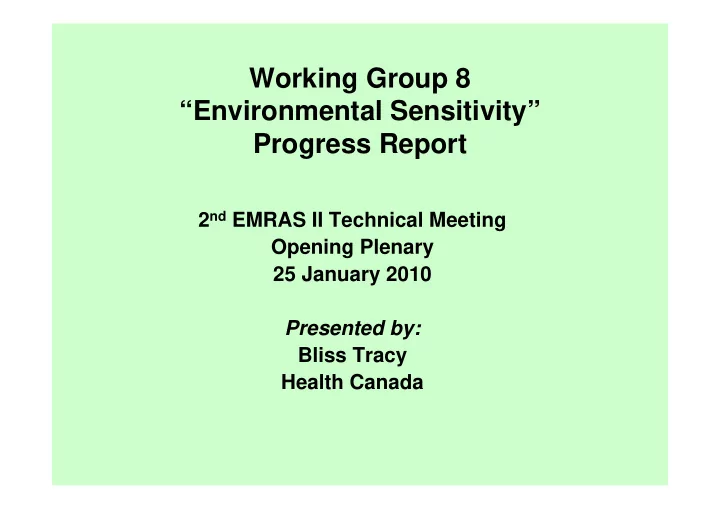

Working Group 8 “Environmental Sensitivity” Progress Report 2 nd EMRAS II Technical Meeting Opening Plenary 25 January 2010 Presented by: Bliss Tracy Health Canada
Participating countries • Austria • Belgium • Brazil • Canada • Finland • France • Germany • Italy • Norway • Sweden
Environmental sensitivity WG Objective: Explore the concept of environmental sensitivity in rural and semi-natural environments in the framework of assessments after an emergency situation Main tasks: • Clarify the concept of environmental sensitivity • Compile a list of sensitivity factors • Design scenarios • Carry out modelling exercises
Task Deadline Review of the concept of environmental sensitivity Literature review June 2009 Draft concept document November 2009 List of environmental sensitivity factors Initial list January 2010 Final list 2011 Scenario Development Design January 2010 Modelling exercises Model results completion End 2010 Analysis of model results June 2011 Final report Preparation of final report End 2011
What is meant by environmental (or radioecological) sensitivity? “The relation between the response of a particular environmental component to a given stress, and the severity of that stress.” [Buckley 1982] ES = Measure of an environmental effect Measure of an external stimulus
Factors that can affect or alter sensitivity • Environmental pathways • Variation in environmental characteristics • Habits (dietary etc.) • Ecosystem response or community countermeasures
Benefits of environmental sensitivity modelling • Risk management & decision-making – Emergency planning and preparedness for existing installations • Identification of areas that may be particularly sensitive • Development of standard response scenarios • Land-use planning – Emergency response • Strategic overview of potentially affected territory • Priority setting for resource allocation in the management of contaminated territories – Decision aid for the location of new installations
Model uncertainty and sensitivity analysis • Uncertainty analysis: – where the greatest uncertainty lies in the model and which parameter estimates need to be improved in order to achieve better predictions • Sensitivity analysis: – which environmental parameters are most “responsible” for ecosystem sensitivity and can thus lead to higher doses
Focus is on non-urban environments • Agricultural • Temperate forest • Alpine • Arctic • Tropical (?)
Source term • Start with the same radionuclide deposition per unit area in different environments • Use a suite of radionuclides to determine which ones are most important in the different environments • Field measurements of deposition following the Chernobyl accident could be one starting point.
Time frame of deposition • The deposition event must be short-term, since we are modelling accident scenarios • We may want to look at the same deposition during different seasons of the year • We need to look at the long term effects (weeks, months, years, decades?) after the deposition event
Environmental compartments • Abiotic – Water bodies – Soil – Sediments – Air (re-suspension)? • Biotic – Plants – Animals – Humans
Endpoints • Radionuclide concentrations in selected abiotic and biotic compartments • Doses to non-human biota • Doses to humans
Tentative agenda for WG 8 Monday 25 January 09:30 – 13:00 Opening Plenary Presentation of models and concepts 14:00 – 17:30 Tuesday 26 January 09:30 – 17:00 Presentation of models and concepts (cont) Wednesday 27 January 09:00 – 12:00 Plenary 13:00 – 17:00 Discussion and design of scenarios Thursday 28 January 09:30 – 17:00 Design of scenarios (continued) Friday 29 January 09:00 – 13:00 Closing Plenary
Recommend
More recommend